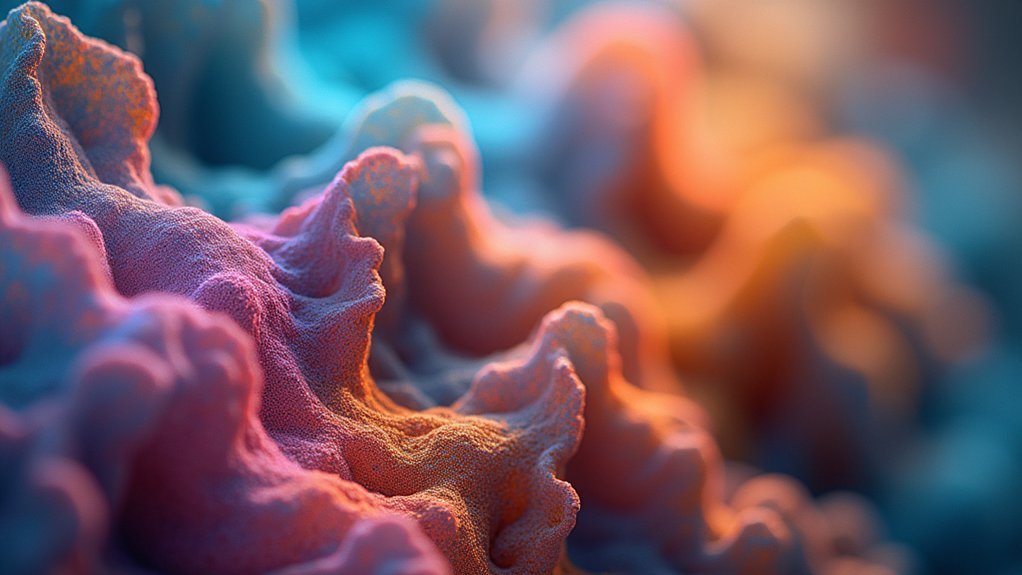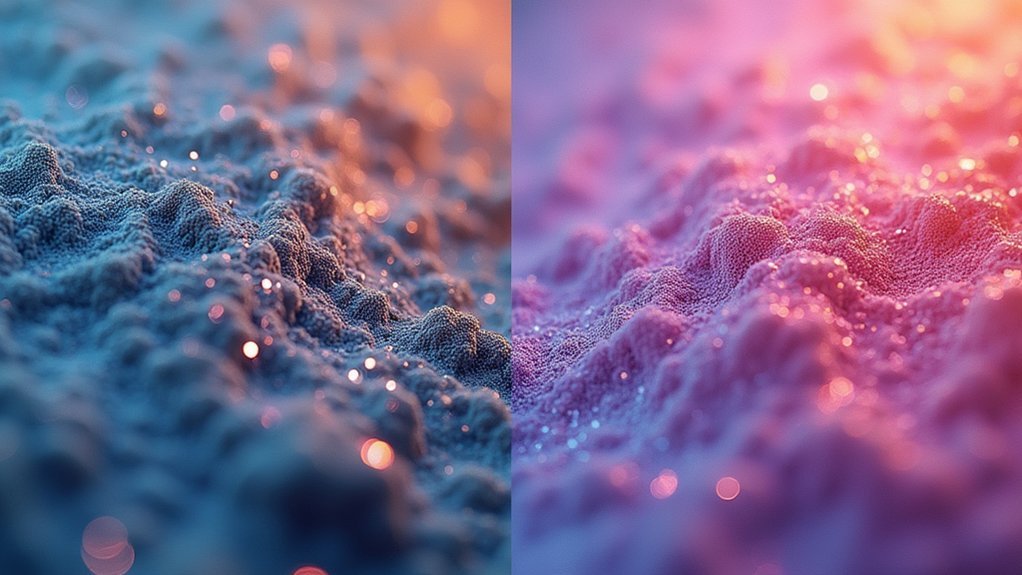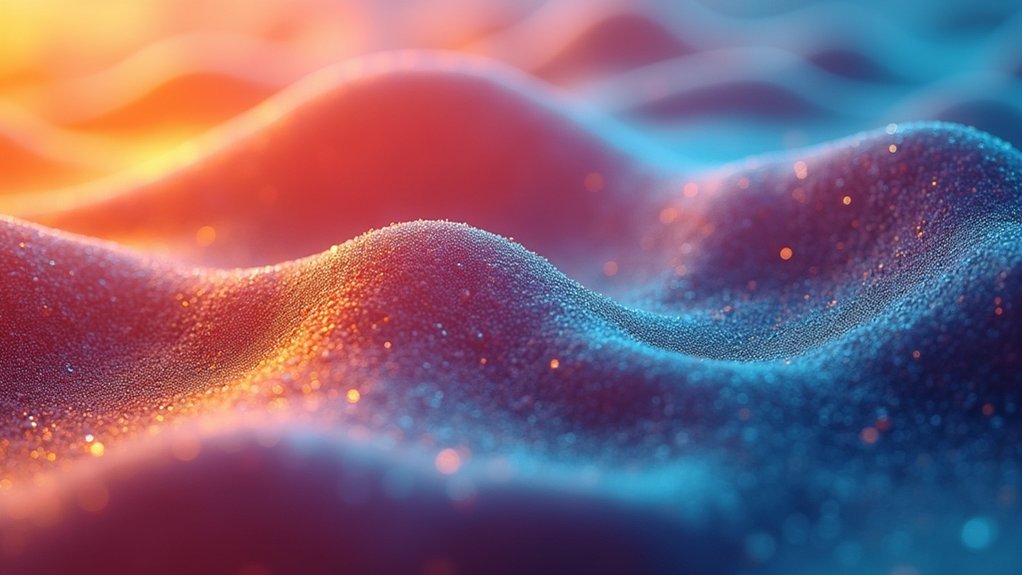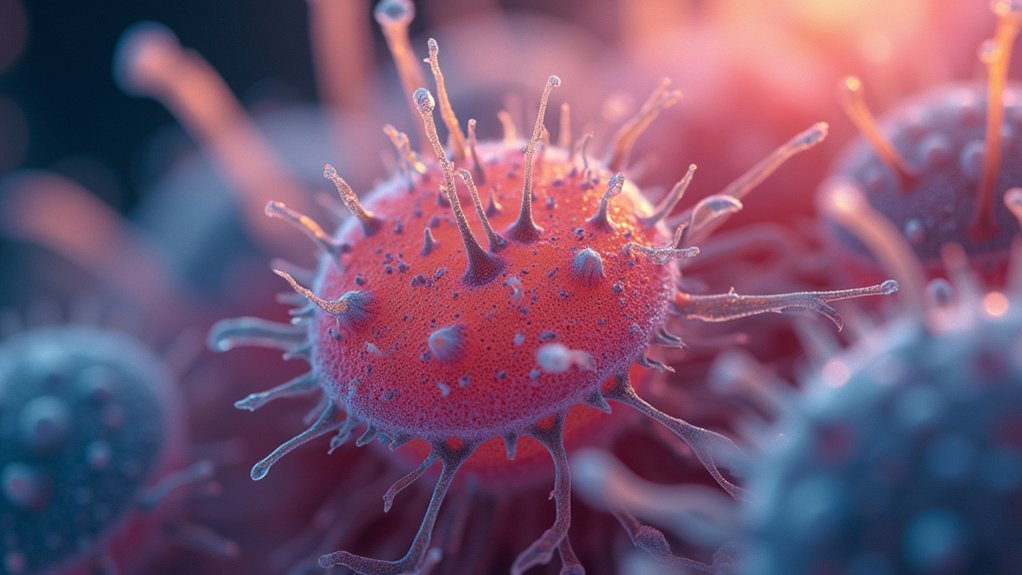For scientific images, non-local means filters typically deliver superior results by preserving fine textures while reducing noise. Gaussian filters work well for thermal noise, while median filters excel at removing salt-and-pepper artifacts without blurring edges. Bilateral filtering effectively balances smoothing with edge preservation in microscopy data. For complex noise patterns, deep learning approaches now outperform traditional methods by adapting to specific image characteristics. Different imaging modalities benefit from tailored filtering techniques for ideal signal-to-noise improvement.
What Noise Filters Give Better Scientific Images?

When selecting filters for scientific image processing, you’ll find several options that excel in different contexts.
Gaussian filters are excellent for reducing high-frequency noise while maintaining overall image quality, which is vital when analyzing fine details in scientific images.
Gaussian filters brilliantly reduce noise while preserving the critical details necessary for accurate scientific image analysis.
If your images contain salt-and-pepper noise, median filters should be your go-to solution. They preserve edges and small features that might be essential for your analysis.
For images with sharp shifts, consider bilateral filters, which intelligently combine spatial and intensity information to enhance image quality.
For superior noise reduction without sacrificing detail, non-local means denoising leverages similar patches across your image.
When dealing with complex scientific data, advanced methods like sparse representation can accurately reconstruct details while minimizing noise interference.
The Impact of Noise on Scientific Image Quality
Although scientists endeavor for pristine data collection, noise invariably infiltrates scientific images, often with significant consequences.
When you’re analyzing microscopy or remote sensing data, this unwanted variation can mask true signals and distort intensity levels, compromising your segmentation and thresholding processes.
You’ll notice that high noise levels dramatically reduce your signal-to-noise ratio (SNR), making it nearly impossible to distinguish genuine features from artifacts.
Different noise types—Gaussian, shot noise—originate from sensor imperfections or environmental factors, requiring specialized denoising algorithms for effective treatment.
Understanding Types of Noise in Microscopy Data

Microscopy data suffers from several distinct noise varieties, each with unique characteristics that impact your analysis differently.
Shot noise follows a Poisson distribution and becomes particularly problematic in low-light conditions due to light’s discrete nature. Meanwhile, Gaussian noise introduces random variations in pixel intensity from thermal fluctuations and sensor imperfections.
The dance of Poisson-distributed shot noise in dim images and Gaussian fluctuations from imperfect sensors requires distinct denoising approaches.
When your microscope’s sensor heats up, thermal noise disrupts silicon bonds, elevating background noise levels.
During signal processing, amplifier noise enters the equation as photoelectrons convert to digital values, potentially obscuring fine details in your images.
Recognizing these noise types isn’t just academic—it directly affects your denoising performance. Different noise filtering techniques target specific noise characteristics, so you’ll need to identify what’s degrading your images before selecting the appropriate filter.
Gaussian Filtering for Smooth Noise Reduction
Among the various noise reduction methods, Gaussian filtering stands out as a foundational technique for addressing noise in scientific images. This approach works by calculating weighted averages of pixel intensities using a Gaussian function, effectively smoothing the image while preserving important structures.
You’ll find Gaussian filtering particularly effective against Gaussian noise—common in modern sensor data. The standard deviation (sigma) parameter lets you control the degree of image blurring; larger values provide more noise reduction but may obscure fine details.
Implementation is straightforward using libraries like OpenCV, where `cv2.GaussianBlur()` gives you adjustable kernel sizes and sigma values.
For your scientific imaging applications, remember to balance noise reduction against detail preservation, as excessive smoothing can eliminate critical information in your data.
Median Filtering: Preserving Edges While Removing Outliers

When researchers need to remove disruptive noise while maintaining essential edge detail, median filtering offers a powerful solution. Unlike Gaussian filters that blur edges, median filtering replaces each pixel value with the median of surrounding neighbors, effectively eliminating outliers without compromising important shifts in your images.
Median filtering eliminates outliers while preserving crucial edge details that standard Gaussian approaches cannot maintain.
This technique particularly excels at removing salt and pepper noise while preserving edges vital for scientific analysis. You’ll find the kernel size selection significant—smaller kernels retain more detail, while larger ones provide stronger noise suppression but risk over-smoothing.
For your scientific imaging applications, median filtering consistently outperforms mean filters when dealing with impulse noise.
You can easily implement this approach using libraries like OpenCV in Python, making it efficient for processing large scientific datasets where structural integrity matters.
Bilateral Filtering for Edge-Preserving Smoothing
Two key characteristics make bilateral filtering exceptional for scientific image processing: its ability to smooth images while simultaneously preserving essential edge details.
Unlike traditional Gaussian filters, bilateral filtering considers both spatial proximity and intensity differences between pixels when calculating weighted averages.
You’ll find this technique particularly valuable when working with microscopy or medical images where preserving structural boundaries is vital.
When you apply bilateral filtering, pixels with similar intensities across edges retain their values, while noise in uniform regions gets smoothed out.
This dual-domain approach guarantees effective noise reduction without compromising important features.
Wavelet-Based Denoising Techniques

Wavelet transforms represent a powerful mathematical framework for scientific image denoising. They decompose your images into frequency components, allowing you to target noise while preserving essential structures.
Wavelet transforms deliver precision denoising by mathematically isolating noise from critical image structures.
Unlike traditional filtering methods, wavelet-based techniques adaptively adjust thresholds based on local noise levels, dramatically improving image quality without sacrificing detail.
- Wavelet thresholding suppresses coefficients associated with noise while preserving those representing actual signal features, maintaining edge integrity.
- These methods offer superior performance in medical imaging and remote sensing applications where fine detail preservation is vital.
- Computational efficiency enables real-time processing for dynamic imaging scenarios requiring rapid noise reduction.
You’ll find wavelet-based denoising particularly valuable when working with complex scientific images where maintaining structural integrity matters as much as reducing noise.
Non-Local Means Algorithms for Detail Preservation
Non-Local Means algorithms offer superior noise reduction by averaging similar pixel patches across the entire image rather than just neighboring pixels.
You’ll notice this approach preserves textures and fine details that traditional filters often obliterate, making NLM particularly valuable for scientific images where structural integrity is critical.
When processing high-noise images, you can rely on NLM’s ability to maintain edge definition while effectively removing noise, even in complex textural regions.
Non-Local Mean Advantages
While traditional filtering approaches often struggle with the noise-detail tradeoff, Non-Local Means (NLM) algorithms excel by leveraging the inherent redundancy found throughout an entire image. This technique uses non-adjacent pixels to perform superior noise reduction while maintaining exceptional image quality.
By analyzing similar patches across the entire image, NLM preserves critical details even when processing heavily degraded scientific images.
You’ll find these distinct advantages when using NLM filters:
- Achieves higher PSNR values than local methods, especially in heavily noisy conditions
- Preserves fine textures and edges critical for scientific analysis while reducing noise
- Offers improved computational efficiency, enabling real-time applications without sacrificing detail preservation
These capabilities make NLM particularly valuable for scientific imaging applications where maintaining structural integrity is essential for accurate interpretation and analysis.
Texture Detail Protection
Texture preservation represents one of the greatest challenges in scientific image denoising—balancing noise reduction against vital detail retention.
When you’re analyzing scientific images, Non-Local Means algorithms offer superior texture detail protection by leveraging redundant patterns throughout the entire image.
Unlike traditional filters that blur important features, NLM algorithms identify similar patches across non-local neighborhoods, maintaining essential textural information while effectively eliminating noise. This approach is particularly valuable in signal processing applications where texture characteristics contain fundamental scientific data.
You’ll find NLM especially effective with high noise levels, where conventional filters often introduce artifacts that compromise image integrity.
Deep Learning Approaches to Scientific Image Denoising

As scientific imaging continues to evolve, deep learning has emerged as a revolutionary approach to image denoising. Convolutional neural networks can now outperform traditional methods by learning complex noise patterns rather than applying fixed algorithms.
Deep learning revolutionizes scientific image denoising by mastering complex noise patterns, outperforming traditional fixed algorithms.
You’ll find that deep learning noise filtering techniques enable high-quality image acquisition without hardware modifications.
These approaches offer several advantages:
- Ability to handle various noise types (Gaussian, Poisson) simultaneously
- Significant enhancement of signal-to-noise ratios while preserving critical features
- Real-time analysis capabilities for dynamic phenomena
Your models can be trained using simulated noisy images, allowing them to generalize across different scientific applications from materials science to biology.
This adaptability makes deep learning particularly valuable when you need to enhance spatio-temporal resolution in time-sensitive experiments.
Comparison of Filter Performance Across Imaging Modalities
When evaluating noise filters for scientific images, you’ll find that their effectiveness varies dramatically across different imaging techniques.
For microscopy images with salt and pepper noise, median filters provide superior results by preserving edges while effectively removing noise spikes.
In contrast, you’ll want to apply Gaussian filters when dealing with thermal noise in astronomical imaging, though this might reduce some image information.
For electron microscopy, non-local means denoising outperforms traditional methods by preserving critical textures.
Material science applications benefit from bilateral filters that balance noise reduction with detail preservation.
If you’re working with complex imaging modalities like MRI or CT scans, sparse representation techniques using K-SVD algorithms offer the best compromise, maintaining essential features while eliminating noise artifacts.
Signal-To-Noise Ratio Improvements With Modern Filters
The evolution of noise filtering techniques has remarkably transformed our ability to extract meaningful data from scientific images. When you’re working with scientific imagery, modern filters can greatly reduce noise while preserving essential details that traditional methods might blur.
- Wiener filters combine low-pass filter techniques with high-pass restoration to improve signal-to-noise ratio without sacrificing image clarity.
- Bilateral filtering applies a weighted average approach that smooths homogeneous regions while maintaining edge definition.
- Non-local means denoising leverages statistical similarities across the entire image, outperforming conventional filters in texture preservation.
Advanced methods like sparse representation and total variation regularization further enhance SNR by intelligently distinguishing between noise and meaningful signal patterns.
These approaches adaptively apply filtering strength, ensuring that noise reduction doesn’t compromise the structural integrity of your scientific images.
Real-Time Processing Considerations for Live Microscopy
Live microscopy presents unique challenges that require specialized noise filtering approaches to maintain critical image details without compromising processing speed.
When you’re capturing dynamic phenomena, traditional filters like Gaussian or median often fail by over-smoothing important details or introducing processing delays.
For ideal real-time processing, you’ll need advanced algorithms that balance efficiency with image quality. Deep learning-based denoising techniques excel here, effectively removing statistical noise while preserving spatial resolution in rapidly acquired images.
Non-local means and sparse representation algorithms adapt particularly well to dynamic imaging scenarios.
Your choice of noise filters should prioritize rapid image acquisition with minimal distortion.
Frequently Asked Questions
Does Noise Affect Image Quality?
Yes, noise considerably impacts your image quality by obscuring details, reducing clarity, and hampering accurate analysis. It distorts pixel values, decreases your SNR, and makes reliable scientific interpretation much more difficult.
What Type of Filters Are Used to Reduce Noise in an Image?
You’ll find several filters to reduce image noise: Gaussian, mean, and median filters for general use, bilateral filters for edge preservation, and non-local means for detail retention while eliminating noise.
Does Noise Reduction Reduce Image Quality?
Noise reduction can both improve and degrade image quality. You’ll see better quality through increased SNR, but you might lose fine details. It’s a trade-off between noise elimination and preserving important image features.
What Are the Different Types of Noise Filters?
You’ll find several noise filter types: spatial filters (like Mean and Median), transform domain methods (including Gaussian), Wiener filters that combine approaches, and advanced techniques such as Non-local Means for superior denoising results.
In Summary
You’ll need to choose your noise filter based on your specific imaging needs. For microscopy, median filters work best for salt-and-pepper noise, while Gaussian filters excel with random noise. Deep learning approaches now offer superior results but require computational resources. Remember that the ideal filter balances noise reduction with preservation of important features. Always validate your filtering method against unprocessed data to guarantee scientific integrity.





Leave a Reply